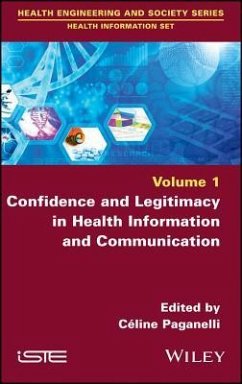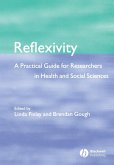Confidence and Legitimacy in Health Information and Communication
Herausgeber: Paganelli, Ceiline
Confidence and Legitimacy in Health Information and Communication
Herausgeber: Paganelli, Ceiline
- Gebundenes Buch
- Merkliste
- Auf die Merkliste
- Bewerten Bewerten
- Teilen
- Produkt teilen
- Produkterinnerung
- Produkterinnerung
The question of trust is crucial in the field of health. First, because health is indicative of particularly strong issues at the societal, regulatory, institutional or individual levels; secondly, because the boundaries between specialized information validated by legitimate instances and uncommitted information have become permeable; finally, because it appears to be central within relations between actors in the field. In this book, we propose to address the trust in terms of the information and communication phenomena that are at work in the health sector, and to look at the process of…mehr
Andere Kunden interessierten sich auch für
![Food and Western Disease Food and Western Disease]() Staffan LindebergFood and Western Disease131,99 €
Staffan LindebergFood and Western Disease131,99 €![Research Handbook for Health Care Research Handbook for Health Care]() Mary HicksonResearch Handbook for Health Care76,99 €
Mary HicksonResearch Handbook for Health Care76,99 €![Improving Healthcare Team Performance Improving Healthcare Team Performance]() Leslie BendalyImproving Healthcare Team Performance60,99 €
Leslie BendalyImproving Healthcare Team Performance60,99 €![Advanced Nutrition and Dietetics in Obesity Advanced Nutrition and Dietetics in Obesity]() Advanced Nutrition and Dietetics in Obesity79,99 €
Advanced Nutrition and Dietetics in Obesity79,99 €![When Your Loved One Has Dementia When Your Loved One Has Dementia]() Joy A GlennerWhen Your Loved One Has Dementia28,99 €
Joy A GlennerWhen Your Loved One Has Dementia28,99 €![Reflexivity Reflexivity]() Linda Finlay / Brendan Gough (eds.)Reflexivity115,99 €
Linda Finlay / Brendan Gough (eds.)Reflexivity115,99 €![Get What's Yours for Health Care Get What's Yours for Health Care]() Philip MoellerGet What's Yours for Health Care22,99 €
Philip MoellerGet What's Yours for Health Care22,99 €-
-
-
The question of trust is crucial in the field of health. First, because health is indicative of particularly strong issues at the societal, regulatory, institutional or individual levels; secondly, because the boundaries between specialized information validated by legitimate instances and uncommitted information have become permeable; finally, because it appears to be central within relations between actors in the field. In this book, we propose to address the trust in terms of the information and communication phenomena that are at work in the health sector, and to look at the process of building the legitimacy of information in the health sector. health.
Hinweis: Dieser Artikel kann nur an eine deutsche Lieferadresse ausgeliefert werden.
Hinweis: Dieser Artikel kann nur an eine deutsche Lieferadresse ausgeliefert werden.
Produktdetails
- Produktdetails
- Verlag: Wiley
- Seitenzahl: 298
- Erscheinungstermin: 18. Dezember 2018
- Englisch
- Abmessung: 231mm x 152mm x 23mm
- Gewicht: 703g
- ISBN-13: 9781786303523
- ISBN-10: 1786303523
- Artikelnr.: 53845818
- Herstellerkennzeichnung
- Libri GmbH
- Europaallee 1
- 36244 Bad Hersfeld
- 06621 890
- Verlag: Wiley
- Seitenzahl: 298
- Erscheinungstermin: 18. Dezember 2018
- Englisch
- Abmessung: 231mm x 152mm x 23mm
- Gewicht: 703g
- ISBN-13: 9781786303523
- ISBN-10: 1786303523
- Artikelnr.: 53845818
- Herstellerkennzeichnung
- Libri GmbH
- Europaallee 1
- 36244 Bad Hersfeld
- 06621 890
Céline PAGANELLI, University Paul-Valéry Montpellier, France.
Preface xi
Céline Paganelli
Introduction xiii
Céline Paganelli
Chapter 1. Information Sources on Childhood Immunization 1
Mylène Costes
1.1. Introduction 1
1.2. Methodology 3
1.3. Vaccination: a proven trust 4
1.3.1. Loss of trust in the vaccination act 4
1.3.2. The vaccination obligation 5
1.4. Health and legitimacy information retrieval: an ambivalent stance 6
1.4.1. Health information research practices 6
1.4.2. Criteria for the legitimacy of online medical information 8
1.5. Parents' knowledge of vaccination 10
1.5.1. Lack of knowledge and limited use of the available information 10
1.5.2. Few parents seek information on vaccination 12
1.6. The opinion of the health professional: a forced trust? 13
1.6.1. A discourse that can change the perception of the vaccination act 13
1.6.2. Maintained trust for health professionals 14
1.7. Conclusion 15
1.8. References 17
Chapter 2. Web 2.0, Parenting and Informational Habitus 21
Maryline Vivion
2.1. Vaccine hesitancy: a manifestation of parental approach 21
2.2. Methodology 24
2.3. Results 26
2.3.1. Diversified information practices 26
2.3.2. The Internet and the importance of choice 28
2.3.3. Mechanisms for determining information credibility 30
2.4. Information reflexivity 33
2.5. Conclusion 35
2.6. References 37
Chapter 3. Trust, Information Sources and the Impact on Decision-Making:
The Example of Vaccination 43
Ève Dubé and Dominique Gagnon
3.1. Introduction 43
3.2. Vaccination: a complex decision influenced by trust 44
3.3. Vaccine hesitancy and trust toward information 46
3.3.1. Quebec parents' trust in the information provided about their
children's vaccination 47
3.4. Media, information and vaccine hesitancy 49
3.4.1. Media and media controversies surrounding vaccination 49
3.4.2. Media controversy surrounding human papillomavirus vaccination in
Quebec 49
3.4.3. Vaccination information research: impact on vaccine decision-making
51
3.5. Challenges and issues of public health communication to increase
vaccine coverage 52
3.6. Conclusion 54
3.7. References 55
Chapter 4. Info-Communication Practices of Autistic Children's Parents on
the Internet: Trust Issues and Legitimacy 67
Clément Dussarps and Denis Dussarps
4.1. Introduction 67
4.2. Search for health information on the Internet: questioning the medical
authority? 68
4.3. Trust and legitimacy: at the heart of the patient's "actorization" 70
4.4. The trust crisis concerning autism 71
4.5. Methodological elements 73
4.6. Sample presentation and statistical limits 74
4.7. The trust crisis in autism: empirical evidence 75
4.8. Habits in information retrieval on autism 79
4.9. Parents' motivations to go on the Internet and compensation research
because of a lack of medical info-communication 80
4.10. Conclusion: overview and perspectives 83
4.11. References 84
Chapter 5. Trust and Information Behavior of French Air Force Flight Nurses
87
Anna Lezon Rivière and Madjid Ihadjadene
5.1. Introduction 87
5.2. Information behavior and situation awareness 88
5.3. Group of actors and study methodology 92
5.4. Analysis of the empirical study's results 93
5.4.1. Building trusting relationships 93
5.4.2. Trust and roles/structure as information sources 95
5.4.3. Trust and communication 96
5.4.4. Trust and skills/knowledge/experience 98
5.4.5. Trust and control 100
5.5. Discussion and conclusion 100
5.6. References 103
Chapter 6. Online Info-Communication Practices in the Face of a Crisis of
Trust in Breast Cancer Prevention 107
Pierre Mignot and Dorsaf Omrane
6.1. Introduction 107
6.2. Breast cancer prevention: a strategic uncertainty? 109
6.2.1. Public health communication: toward a culture of prevention? 110
6.2.2. Breast cancer preventions in question: measures and actors 112
6.3. Online info-communication practices of the population concerned by
breast cancer prevention 117
6.3.1. Methodological choices for the analysis of an online exchange area
118
6.3.2. Two trust measures: between judgment and promises 120
6.4. Discussion and conclusion 128
6.5. References 129
Chapter 7. Trust between Constraints and Limitations of Information
Behaviors Among Public Health Policy Actors: The Case of Music Therapy 135
Nathalie Verdier
7.1. Introduction 135
7.2. Context of emergence of the question of trust: the case of music
therapy 136
7.3. Research field 138
7.4. Devices to observe 140
7.5. Methodology 141
7.6. Trust apprehended through the digital document 142
7.7. Trust apprehended via institutional sites 147
7.8. Trust apprehended through digital devices 148
7.9. Conclusion 152
7.10. Annex 153
7.10.1. Parliamentary documents 153
7.10.2. Documents distributed by the HAS 153
7.10.3. Attribution documents created using screenshots from institutional
website pages via the following links 154
7.11. References154
Chapter 8. Hospital Trust and Legitimacy: Internal Medicine in the French
Health Care System 159
Paméla Baillette and Michel Mannarini
8.1. Introduction 159
8.2. The interface-actor as a transversal integrator 160
8.2.1. Presentation of the interface-actor 160
8.2.2. Interface-actor missions 162
8.3. Internal medicine at the interface of hospital services 165
8.3.1. Internal medicine and the role of the internist 165
8.3.2. Readability and notoriety of internal medicine 168
8.3.3. Evolution of internal medicine 171
8.4. Conclusion 172
8.5. References 173
Chapter 9. From Health Actors' Information-Communication Issues in the
Workplace to Obstacles when Establishing a Relationship of Trust 177
Aurélia Dumas
9.1. Introduction 177
9.2. Building the company's legitimacy in occupational health safety 179
9.2.1. The employer's obligations 179
9.2.2. Biopolitical perspective and company's legitimacy 180
9.2.3. Health actors: health information and communication producers within
the company 182
9.3. Info-communication issues of health actors within the company 183
9.3.1. Between distance and alignment regarding institutional communication
183
9.3.2. The lack of visibility and burden of health actors 185
9.4. The company and its communication policies: obstacles to establishing
a relationship of trust 186
9.4.1. Primacy of control logic and employee concealment strategies 186
9.4.2. The difficulty of talking for employees 187
9.5. Conclusion 188
9.6. References 190
Chapter 10. Connected Health: Between Common Aspirations and Specific
Interests 195
Adrian Staii
10.1. Introduction: connected health, a notion in search of a referent 195
10.2. Multiple paths of a historical disempowerment of health 198
10.3. New economic configurations of connected health 202
10.4. Conclusion: trust, an ever-new challenge 214
10.5. References 218
Chapter 11. Expressions of Trust in the Home-Based Care Relationship and
Areas of Legitimacy in the Context of Digital Media 223
Géraldine Goulinet-Fité and Didier Paquelin
11.1. Introduction 223
11.2. Care: a relationship between actors 224
11.2.1. Structure of treatment: logics forged concerning epistemological
foundations between cure and care 225
11.2.2. Interactional dimensions and functions of the care relationship 228
11.3. Dynamic of building trust in the home-based care relationship 231
11.3.1. Trust in the doctor-patient relationship: a notion rooted in
privacy 234
11.3.2. Trust in the caregiver-patient relationship: a pattern shaped by
esteem 234
11.3.3. Trust in the helping-patient relationship: a domestic commitment of
proximity 235
11.4. Digital mediatization of the relationship based on the care device
238
11.4.1. Singularity of media coverage of the relationship with ICT 239
11.4.2. Singularity of media coverage of care with ICT 240
11.4.3. Trust climate in the context of digital media 241
11.5. Forecast and conclusion 243
11.6. References 245
Chapter 12. The Electronic Medical Record: Standardization Issues and
Personalization of Information for Health Professionals 251
David Morquin and Roxana Ologeanu-Taddei
12.1. Introduction to EMRs 251
12.2. Literature review 253
12.3. Exploratory empirical study 256
12.3.1. Study context 256
12.3.2. Methodology 258
12.4. Discussion and conclusion 265
12.5. References 267
Postface 273
Viviane Couzinet
List of Authors 275
Index 277
Céline Paganelli
Introduction xiii
Céline Paganelli
Chapter 1. Information Sources on Childhood Immunization 1
Mylène Costes
1.1. Introduction 1
1.2. Methodology 3
1.3. Vaccination: a proven trust 4
1.3.1. Loss of trust in the vaccination act 4
1.3.2. The vaccination obligation 5
1.4. Health and legitimacy information retrieval: an ambivalent stance 6
1.4.1. Health information research practices 6
1.4.2. Criteria for the legitimacy of online medical information 8
1.5. Parents' knowledge of vaccination 10
1.5.1. Lack of knowledge and limited use of the available information 10
1.5.2. Few parents seek information on vaccination 12
1.6. The opinion of the health professional: a forced trust? 13
1.6.1. A discourse that can change the perception of the vaccination act 13
1.6.2. Maintained trust for health professionals 14
1.7. Conclusion 15
1.8. References 17
Chapter 2. Web 2.0, Parenting and Informational Habitus 21
Maryline Vivion
2.1. Vaccine hesitancy: a manifestation of parental approach 21
2.2. Methodology 24
2.3. Results 26
2.3.1. Diversified information practices 26
2.3.2. The Internet and the importance of choice 28
2.3.3. Mechanisms for determining information credibility 30
2.4. Information reflexivity 33
2.5. Conclusion 35
2.6. References 37
Chapter 3. Trust, Information Sources and the Impact on Decision-Making:
The Example of Vaccination 43
Ève Dubé and Dominique Gagnon
3.1. Introduction 43
3.2. Vaccination: a complex decision influenced by trust 44
3.3. Vaccine hesitancy and trust toward information 46
3.3.1. Quebec parents' trust in the information provided about their
children's vaccination 47
3.4. Media, information and vaccine hesitancy 49
3.4.1. Media and media controversies surrounding vaccination 49
3.4.2. Media controversy surrounding human papillomavirus vaccination in
Quebec 49
3.4.3. Vaccination information research: impact on vaccine decision-making
51
3.5. Challenges and issues of public health communication to increase
vaccine coverage 52
3.6. Conclusion 54
3.7. References 55
Chapter 4. Info-Communication Practices of Autistic Children's Parents on
the Internet: Trust Issues and Legitimacy 67
Clément Dussarps and Denis Dussarps
4.1. Introduction 67
4.2. Search for health information on the Internet: questioning the medical
authority? 68
4.3. Trust and legitimacy: at the heart of the patient's "actorization" 70
4.4. The trust crisis concerning autism 71
4.5. Methodological elements 73
4.6. Sample presentation and statistical limits 74
4.7. The trust crisis in autism: empirical evidence 75
4.8. Habits in information retrieval on autism 79
4.9. Parents' motivations to go on the Internet and compensation research
because of a lack of medical info-communication 80
4.10. Conclusion: overview and perspectives 83
4.11. References 84
Chapter 5. Trust and Information Behavior of French Air Force Flight Nurses
87
Anna Lezon Rivière and Madjid Ihadjadene
5.1. Introduction 87
5.2. Information behavior and situation awareness 88
5.3. Group of actors and study methodology 92
5.4. Analysis of the empirical study's results 93
5.4.1. Building trusting relationships 93
5.4.2. Trust and roles/structure as information sources 95
5.4.3. Trust and communication 96
5.4.4. Trust and skills/knowledge/experience 98
5.4.5. Trust and control 100
5.5. Discussion and conclusion 100
5.6. References 103
Chapter 6. Online Info-Communication Practices in the Face of a Crisis of
Trust in Breast Cancer Prevention 107
Pierre Mignot and Dorsaf Omrane
6.1. Introduction 107
6.2. Breast cancer prevention: a strategic uncertainty? 109
6.2.1. Public health communication: toward a culture of prevention? 110
6.2.2. Breast cancer preventions in question: measures and actors 112
6.3. Online info-communication practices of the population concerned by
breast cancer prevention 117
6.3.1. Methodological choices for the analysis of an online exchange area
118
6.3.2. Two trust measures: between judgment and promises 120
6.4. Discussion and conclusion 128
6.5. References 129
Chapter 7. Trust between Constraints and Limitations of Information
Behaviors Among Public Health Policy Actors: The Case of Music Therapy 135
Nathalie Verdier
7.1. Introduction 135
7.2. Context of emergence of the question of trust: the case of music
therapy 136
7.3. Research field 138
7.4. Devices to observe 140
7.5. Methodology 141
7.6. Trust apprehended through the digital document 142
7.7. Trust apprehended via institutional sites 147
7.8. Trust apprehended through digital devices 148
7.9. Conclusion 152
7.10. Annex 153
7.10.1. Parliamentary documents 153
7.10.2. Documents distributed by the HAS 153
7.10.3. Attribution documents created using screenshots from institutional
website pages via the following links 154
7.11. References154
Chapter 8. Hospital Trust and Legitimacy: Internal Medicine in the French
Health Care System 159
Paméla Baillette and Michel Mannarini
8.1. Introduction 159
8.2. The interface-actor as a transversal integrator 160
8.2.1. Presentation of the interface-actor 160
8.2.2. Interface-actor missions 162
8.3. Internal medicine at the interface of hospital services 165
8.3.1. Internal medicine and the role of the internist 165
8.3.2. Readability and notoriety of internal medicine 168
8.3.3. Evolution of internal medicine 171
8.4. Conclusion 172
8.5. References 173
Chapter 9. From Health Actors' Information-Communication Issues in the
Workplace to Obstacles when Establishing a Relationship of Trust 177
Aurélia Dumas
9.1. Introduction 177
9.2. Building the company's legitimacy in occupational health safety 179
9.2.1. The employer's obligations 179
9.2.2. Biopolitical perspective and company's legitimacy 180
9.2.3. Health actors: health information and communication producers within
the company 182
9.3. Info-communication issues of health actors within the company 183
9.3.1. Between distance and alignment regarding institutional communication
183
9.3.2. The lack of visibility and burden of health actors 185
9.4. The company and its communication policies: obstacles to establishing
a relationship of trust 186
9.4.1. Primacy of control logic and employee concealment strategies 186
9.4.2. The difficulty of talking for employees 187
9.5. Conclusion 188
9.6. References 190
Chapter 10. Connected Health: Between Common Aspirations and Specific
Interests 195
Adrian Staii
10.1. Introduction: connected health, a notion in search of a referent 195
10.2. Multiple paths of a historical disempowerment of health 198
10.3. New economic configurations of connected health 202
10.4. Conclusion: trust, an ever-new challenge 214
10.5. References 218
Chapter 11. Expressions of Trust in the Home-Based Care Relationship and
Areas of Legitimacy in the Context of Digital Media 223
Géraldine Goulinet-Fité and Didier Paquelin
11.1. Introduction 223
11.2. Care: a relationship between actors 224
11.2.1. Structure of treatment: logics forged concerning epistemological
foundations between cure and care 225
11.2.2. Interactional dimensions and functions of the care relationship 228
11.3. Dynamic of building trust in the home-based care relationship 231
11.3.1. Trust in the doctor-patient relationship: a notion rooted in
privacy 234
11.3.2. Trust in the caregiver-patient relationship: a pattern shaped by
esteem 234
11.3.3. Trust in the helping-patient relationship: a domestic commitment of
proximity 235
11.4. Digital mediatization of the relationship based on the care device
238
11.4.1. Singularity of media coverage of the relationship with ICT 239
11.4.2. Singularity of media coverage of care with ICT 240
11.4.3. Trust climate in the context of digital media 241
11.5. Forecast and conclusion 243
11.6. References 245
Chapter 12. The Electronic Medical Record: Standardization Issues and
Personalization of Information for Health Professionals 251
David Morquin and Roxana Ologeanu-Taddei
12.1. Introduction to EMRs 251
12.2. Literature review 253
12.3. Exploratory empirical study 256
12.3.1. Study context 256
12.3.2. Methodology 258
12.4. Discussion and conclusion 265
12.5. References 267
Postface 273
Viviane Couzinet
List of Authors 275
Index 277
Preface xi
Céline Paganelli
Introduction xiii
Céline Paganelli
Chapter 1. Information Sources on Childhood Immunization 1
Mylène Costes
1.1. Introduction 1
1.2. Methodology 3
1.3. Vaccination: a proven trust 4
1.3.1. Loss of trust in the vaccination act 4
1.3.2. The vaccination obligation 5
1.4. Health and legitimacy information retrieval: an ambivalent stance 6
1.4.1. Health information research practices 6
1.4.2. Criteria for the legitimacy of online medical information 8
1.5. Parents' knowledge of vaccination 10
1.5.1. Lack of knowledge and limited use of the available information 10
1.5.2. Few parents seek information on vaccination 12
1.6. The opinion of the health professional: a forced trust? 13
1.6.1. A discourse that can change the perception of the vaccination act 13
1.6.2. Maintained trust for health professionals 14
1.7. Conclusion 15
1.8. References 17
Chapter 2. Web 2.0, Parenting and Informational Habitus 21
Maryline Vivion
2.1. Vaccine hesitancy: a manifestation of parental approach 21
2.2. Methodology 24
2.3. Results 26
2.3.1. Diversified information practices 26
2.3.2. The Internet and the importance of choice 28
2.3.3. Mechanisms for determining information credibility 30
2.4. Information reflexivity 33
2.5. Conclusion 35
2.6. References 37
Chapter 3. Trust, Information Sources and the Impact on Decision-Making:
The Example of Vaccination 43
Ève Dubé and Dominique Gagnon
3.1. Introduction 43
3.2. Vaccination: a complex decision influenced by trust 44
3.3. Vaccine hesitancy and trust toward information 46
3.3.1. Quebec parents' trust in the information provided about their
children's vaccination 47
3.4. Media, information and vaccine hesitancy 49
3.4.1. Media and media controversies surrounding vaccination 49
3.4.2. Media controversy surrounding human papillomavirus vaccination in
Quebec 49
3.4.3. Vaccination information research: impact on vaccine decision-making
51
3.5. Challenges and issues of public health communication to increase
vaccine coverage 52
3.6. Conclusion 54
3.7. References 55
Chapter 4. Info-Communication Practices of Autistic Children's Parents on
the Internet: Trust Issues and Legitimacy 67
Clément Dussarps and Denis Dussarps
4.1. Introduction 67
4.2. Search for health information on the Internet: questioning the medical
authority? 68
4.3. Trust and legitimacy: at the heart of the patient's "actorization" 70
4.4. The trust crisis concerning autism 71
4.5. Methodological elements 73
4.6. Sample presentation and statistical limits 74
4.7. The trust crisis in autism: empirical evidence 75
4.8. Habits in information retrieval on autism 79
4.9. Parents' motivations to go on the Internet and compensation research
because of a lack of medical info-communication 80
4.10. Conclusion: overview and perspectives 83
4.11. References 84
Chapter 5. Trust and Information Behavior of French Air Force Flight Nurses
87
Anna Lezon Rivière and Madjid Ihadjadene
5.1. Introduction 87
5.2. Information behavior and situation awareness 88
5.3. Group of actors and study methodology 92
5.4. Analysis of the empirical study's results 93
5.4.1. Building trusting relationships 93
5.4.2. Trust and roles/structure as information sources 95
5.4.3. Trust and communication 96
5.4.4. Trust and skills/knowledge/experience 98
5.4.5. Trust and control 100
5.5. Discussion and conclusion 100
5.6. References 103
Chapter 6. Online Info-Communication Practices in the Face of a Crisis of
Trust in Breast Cancer Prevention 107
Pierre Mignot and Dorsaf Omrane
6.1. Introduction 107
6.2. Breast cancer prevention: a strategic uncertainty? 109
6.2.1. Public health communication: toward a culture of prevention? 110
6.2.2. Breast cancer preventions in question: measures and actors 112
6.3. Online info-communication practices of the population concerned by
breast cancer prevention 117
6.3.1. Methodological choices for the analysis of an online exchange area
118
6.3.2. Two trust measures: between judgment and promises 120
6.4. Discussion and conclusion 128
6.5. References 129
Chapter 7. Trust between Constraints and Limitations of Information
Behaviors Among Public Health Policy Actors: The Case of Music Therapy 135
Nathalie Verdier
7.1. Introduction 135
7.2. Context of emergence of the question of trust: the case of music
therapy 136
7.3. Research field 138
7.4. Devices to observe 140
7.5. Methodology 141
7.6. Trust apprehended through the digital document 142
7.7. Trust apprehended via institutional sites 147
7.8. Trust apprehended through digital devices 148
7.9. Conclusion 152
7.10. Annex 153
7.10.1. Parliamentary documents 153
7.10.2. Documents distributed by the HAS 153
7.10.3. Attribution documents created using screenshots from institutional
website pages via the following links 154
7.11. References154
Chapter 8. Hospital Trust and Legitimacy: Internal Medicine in the French
Health Care System 159
Paméla Baillette and Michel Mannarini
8.1. Introduction 159
8.2. The interface-actor as a transversal integrator 160
8.2.1. Presentation of the interface-actor 160
8.2.2. Interface-actor missions 162
8.3. Internal medicine at the interface of hospital services 165
8.3.1. Internal medicine and the role of the internist 165
8.3.2. Readability and notoriety of internal medicine 168
8.3.3. Evolution of internal medicine 171
8.4. Conclusion 172
8.5. References 173
Chapter 9. From Health Actors' Information-Communication Issues in the
Workplace to Obstacles when Establishing a Relationship of Trust 177
Aurélia Dumas
9.1. Introduction 177
9.2. Building the company's legitimacy in occupational health safety 179
9.2.1. The employer's obligations 179
9.2.2. Biopolitical perspective and company's legitimacy 180
9.2.3. Health actors: health information and communication producers within
the company 182
9.3. Info-communication issues of health actors within the company 183
9.3.1. Between distance and alignment regarding institutional communication
183
9.3.2. The lack of visibility and burden of health actors 185
9.4. The company and its communication policies: obstacles to establishing
a relationship of trust 186
9.4.1. Primacy of control logic and employee concealment strategies 186
9.4.2. The difficulty of talking for employees 187
9.5. Conclusion 188
9.6. References 190
Chapter 10. Connected Health: Between Common Aspirations and Specific
Interests 195
Adrian Staii
10.1. Introduction: connected health, a notion in search of a referent 195
10.2. Multiple paths of a historical disempowerment of health 198
10.3. New economic configurations of connected health 202
10.4. Conclusion: trust, an ever-new challenge 214
10.5. References 218
Chapter 11. Expressions of Trust in the Home-Based Care Relationship and
Areas of Legitimacy in the Context of Digital Media 223
Géraldine Goulinet-Fité and Didier Paquelin
11.1. Introduction 223
11.2. Care: a relationship between actors 224
11.2.1. Structure of treatment: logics forged concerning epistemological
foundations between cure and care 225
11.2.2. Interactional dimensions and functions of the care relationship 228
11.3. Dynamic of building trust in the home-based care relationship 231
11.3.1. Trust in the doctor-patient relationship: a notion rooted in
privacy 234
11.3.2. Trust in the caregiver-patient relationship: a pattern shaped by
esteem 234
11.3.3. Trust in the helping-patient relationship: a domestic commitment of
proximity 235
11.4. Digital mediatization of the relationship based on the care device
238
11.4.1. Singularity of media coverage of the relationship with ICT 239
11.4.2. Singularity of media coverage of care with ICT 240
11.4.3. Trust climate in the context of digital media 241
11.5. Forecast and conclusion 243
11.6. References 245
Chapter 12. The Electronic Medical Record: Standardization Issues and
Personalization of Information for Health Professionals 251
David Morquin and Roxana Ologeanu-Taddei
12.1. Introduction to EMRs 251
12.2. Literature review 253
12.3. Exploratory empirical study 256
12.3.1. Study context 256
12.3.2. Methodology 258
12.4. Discussion and conclusion 265
12.5. References 267
Postface 273
Viviane Couzinet
List of Authors 275
Index 277
Céline Paganelli
Introduction xiii
Céline Paganelli
Chapter 1. Information Sources on Childhood Immunization 1
Mylène Costes
1.1. Introduction 1
1.2. Methodology 3
1.3. Vaccination: a proven trust 4
1.3.1. Loss of trust in the vaccination act 4
1.3.2. The vaccination obligation 5
1.4. Health and legitimacy information retrieval: an ambivalent stance 6
1.4.1. Health information research practices 6
1.4.2. Criteria for the legitimacy of online medical information 8
1.5. Parents' knowledge of vaccination 10
1.5.1. Lack of knowledge and limited use of the available information 10
1.5.2. Few parents seek information on vaccination 12
1.6. The opinion of the health professional: a forced trust? 13
1.6.1. A discourse that can change the perception of the vaccination act 13
1.6.2. Maintained trust for health professionals 14
1.7. Conclusion 15
1.8. References 17
Chapter 2. Web 2.0, Parenting and Informational Habitus 21
Maryline Vivion
2.1. Vaccine hesitancy: a manifestation of parental approach 21
2.2. Methodology 24
2.3. Results 26
2.3.1. Diversified information practices 26
2.3.2. The Internet and the importance of choice 28
2.3.3. Mechanisms for determining information credibility 30
2.4. Information reflexivity 33
2.5. Conclusion 35
2.6. References 37
Chapter 3. Trust, Information Sources and the Impact on Decision-Making:
The Example of Vaccination 43
Ève Dubé and Dominique Gagnon
3.1. Introduction 43
3.2. Vaccination: a complex decision influenced by trust 44
3.3. Vaccine hesitancy and trust toward information 46
3.3.1. Quebec parents' trust in the information provided about their
children's vaccination 47
3.4. Media, information and vaccine hesitancy 49
3.4.1. Media and media controversies surrounding vaccination 49
3.4.2. Media controversy surrounding human papillomavirus vaccination in
Quebec 49
3.4.3. Vaccination information research: impact on vaccine decision-making
51
3.5. Challenges and issues of public health communication to increase
vaccine coverage 52
3.6. Conclusion 54
3.7. References 55
Chapter 4. Info-Communication Practices of Autistic Children's Parents on
the Internet: Trust Issues and Legitimacy 67
Clément Dussarps and Denis Dussarps
4.1. Introduction 67
4.2. Search for health information on the Internet: questioning the medical
authority? 68
4.3. Trust and legitimacy: at the heart of the patient's "actorization" 70
4.4. The trust crisis concerning autism 71
4.5. Methodological elements 73
4.6. Sample presentation and statistical limits 74
4.7. The trust crisis in autism: empirical evidence 75
4.8. Habits in information retrieval on autism 79
4.9. Parents' motivations to go on the Internet and compensation research
because of a lack of medical info-communication 80
4.10. Conclusion: overview and perspectives 83
4.11. References 84
Chapter 5. Trust and Information Behavior of French Air Force Flight Nurses
87
Anna Lezon Rivière and Madjid Ihadjadene
5.1. Introduction 87
5.2. Information behavior and situation awareness 88
5.3. Group of actors and study methodology 92
5.4. Analysis of the empirical study's results 93
5.4.1. Building trusting relationships 93
5.4.2. Trust and roles/structure as information sources 95
5.4.3. Trust and communication 96
5.4.4. Trust and skills/knowledge/experience 98
5.4.5. Trust and control 100
5.5. Discussion and conclusion 100
5.6. References 103
Chapter 6. Online Info-Communication Practices in the Face of a Crisis of
Trust in Breast Cancer Prevention 107
Pierre Mignot and Dorsaf Omrane
6.1. Introduction 107
6.2. Breast cancer prevention: a strategic uncertainty? 109
6.2.1. Public health communication: toward a culture of prevention? 110
6.2.2. Breast cancer preventions in question: measures and actors 112
6.3. Online info-communication practices of the population concerned by
breast cancer prevention 117
6.3.1. Methodological choices for the analysis of an online exchange area
118
6.3.2. Two trust measures: between judgment and promises 120
6.4. Discussion and conclusion 128
6.5. References 129
Chapter 7. Trust between Constraints and Limitations of Information
Behaviors Among Public Health Policy Actors: The Case of Music Therapy 135
Nathalie Verdier
7.1. Introduction 135
7.2. Context of emergence of the question of trust: the case of music
therapy 136
7.3. Research field 138
7.4. Devices to observe 140
7.5. Methodology 141
7.6. Trust apprehended through the digital document 142
7.7. Trust apprehended via institutional sites 147
7.8. Trust apprehended through digital devices 148
7.9. Conclusion 152
7.10. Annex 153
7.10.1. Parliamentary documents 153
7.10.2. Documents distributed by the HAS 153
7.10.3. Attribution documents created using screenshots from institutional
website pages via the following links 154
7.11. References154
Chapter 8. Hospital Trust and Legitimacy: Internal Medicine in the French
Health Care System 159
Paméla Baillette and Michel Mannarini
8.1. Introduction 159
8.2. The interface-actor as a transversal integrator 160
8.2.1. Presentation of the interface-actor 160
8.2.2. Interface-actor missions 162
8.3. Internal medicine at the interface of hospital services 165
8.3.1. Internal medicine and the role of the internist 165
8.3.2. Readability and notoriety of internal medicine 168
8.3.3. Evolution of internal medicine 171
8.4. Conclusion 172
8.5. References 173
Chapter 9. From Health Actors' Information-Communication Issues in the
Workplace to Obstacles when Establishing a Relationship of Trust 177
Aurélia Dumas
9.1. Introduction 177
9.2. Building the company's legitimacy in occupational health safety 179
9.2.1. The employer's obligations 179
9.2.2. Biopolitical perspective and company's legitimacy 180
9.2.3. Health actors: health information and communication producers within
the company 182
9.3. Info-communication issues of health actors within the company 183
9.3.1. Between distance and alignment regarding institutional communication
183
9.3.2. The lack of visibility and burden of health actors 185
9.4. The company and its communication policies: obstacles to establishing
a relationship of trust 186
9.4.1. Primacy of control logic and employee concealment strategies 186
9.4.2. The difficulty of talking for employees 187
9.5. Conclusion 188
9.6. References 190
Chapter 10. Connected Health: Between Common Aspirations and Specific
Interests 195
Adrian Staii
10.1. Introduction: connected health, a notion in search of a referent 195
10.2. Multiple paths of a historical disempowerment of health 198
10.3. New economic configurations of connected health 202
10.4. Conclusion: trust, an ever-new challenge 214
10.5. References 218
Chapter 11. Expressions of Trust in the Home-Based Care Relationship and
Areas of Legitimacy in the Context of Digital Media 223
Géraldine Goulinet-Fité and Didier Paquelin
11.1. Introduction 223
11.2. Care: a relationship between actors 224
11.2.1. Structure of treatment: logics forged concerning epistemological
foundations between cure and care 225
11.2.2. Interactional dimensions and functions of the care relationship 228
11.3. Dynamic of building trust in the home-based care relationship 231
11.3.1. Trust in the doctor-patient relationship: a notion rooted in
privacy 234
11.3.2. Trust in the caregiver-patient relationship: a pattern shaped by
esteem 234
11.3.3. Trust in the helping-patient relationship: a domestic commitment of
proximity 235
11.4. Digital mediatization of the relationship based on the care device
238
11.4.1. Singularity of media coverage of the relationship with ICT 239
11.4.2. Singularity of media coverage of care with ICT 240
11.4.3. Trust climate in the context of digital media 241
11.5. Forecast and conclusion 243
11.6. References 245
Chapter 12. The Electronic Medical Record: Standardization Issues and
Personalization of Information for Health Professionals 251
David Morquin and Roxana Ologeanu-Taddei
12.1. Introduction to EMRs 251
12.2. Literature review 253
12.3. Exploratory empirical study 256
12.3.1. Study context 256
12.3.2. Methodology 258
12.4. Discussion and conclusion 265
12.5. References 267
Postface 273
Viviane Couzinet
List of Authors 275
Index 277








